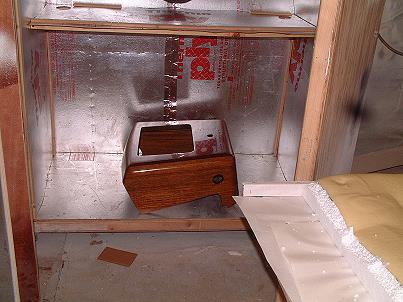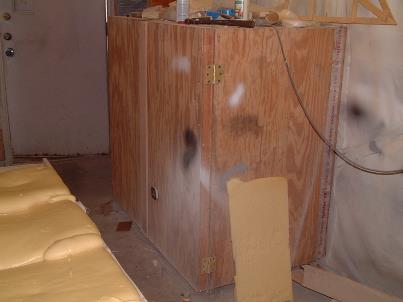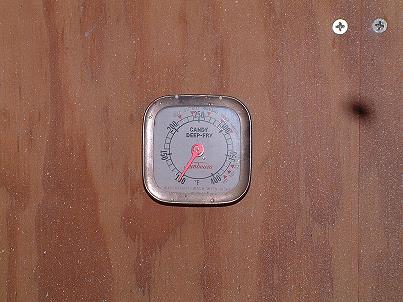
 |
Above the console is being post cured in my hot box. After three days of curing naturally under ambient conditions, the post curing cycle was run at 100° - 110° F for a 24 hour period. This brought the Epifanes RapidClear to harder finish and further equalized the teak and epoxy joints. I feel confident that the present structural characteristics have been thoroughly locked in...
The hot box is a marvelous tool when I need to post cure, hasten the cure, or generally reduce the moisture content of an item. It is powered by a pair of 300 watt infa-red heat lamps and a small air circulating muffin fan. The box was built from some old 1/2" plywood shelving. The interior was insulated with fiberglass batting and covered with a reflective insulation board, (Thermo-Ply®).
Under the lamps, a baffle shelf was installed to prevent the lamps from shinning directly onto the object being heated. The heat is controlled by a dimmer switch, monitored by a cooking thermometer inserted low on the right door. The maximum heat range for the box is 190° F.
About Post Curing: (From Vyncolit N.V.)
Improve Dimensional stability, Heat and Compressive Creep Resistance
"By post-curing the degree of cross-linking is increased. This limits not only the movement of large molecular segments but also limits the microscopic movement of polymer segments. The result is the completion of post-shrinkage and the enhancement of heat and creep resistance.
Shrinkage during controlled post-curing is predictable. Higher temperatures and longer post-curing times generally result in the greatest shrinkage. Although loss of volatiles is accompanied by volume shrinkage, exposure to excessively high temperatures can also cause an irreversible expansion due to high internal gas pressures or blistering of the part; Therefore a stepwise post-curing cycle works best, where the initial temperature is kept well below the initial Tg.
The post-curing temperature should be maintained below the Tg as It rises, so that the internal pressure is contained by the high Modulus of the moulding. In addition post-curing can be used to relieve moulded-in stresses, improve the exposure to elevated temperature and also increase the creep resistance and surface hardness of moulded parts."
While the post curing description above is more generally addressing polymer molds and parts, the same principals are applied to items constructed of wood & resin systems...
 |  |
With post curing complete, the console is allowed to cool back to ambiant temperature for several hours before any sanding is done.
After close inspection, only a few spots need to be leveled out slightly with sand paper, the rest of the surface can be scuffed with the medium refinishing pad before proceeding into the final varnish application of Epifanes WoodFinish Gloss.
More to come later....
834 Scott Dr. LLANO, TX 78643 Telephone 325.248.0809
Web site questions or comments to: bertram31@bertram31.com